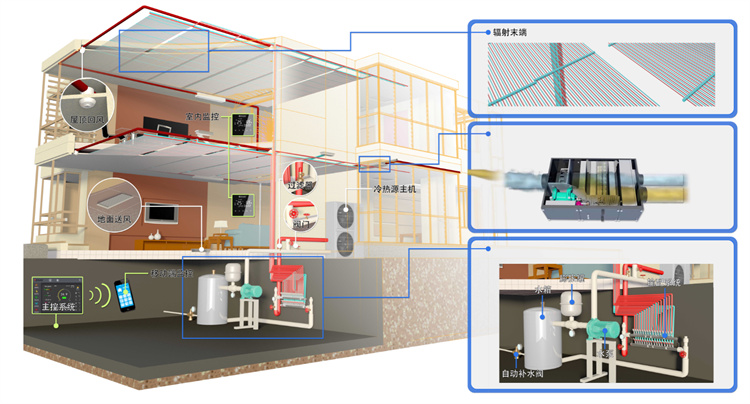[Solution]

Many families will buy central air-conditioning equipment, but with the improvement of economic conditions and the strengthening of experience needs, more and more people have higher requirements for indoor heating and cooling equipment, hoping to achieve better through the continuous upgrading of technological equipment. Warm and cold experience. Demand determines the market, and radiant air conditioners have begun to enter the field of vision of many families. So apart from the name difference, what is the difference between it and the central air conditioner?
How it works
1. Central air conditioning: It consists of one or more cold and heat source systems and multiple air conditioning systems. The principle of liquid vaporization refrigeration is adopted to provide the required cooling capacity for the air-conditioning system to offset the heat load of the indoor environment; the heating system provides the required heat for the air-conditioning system to offset the indoor cooling load.
2. Radiant air conditioner: refers to the heating and cooling system mainly based on thermal radiation and supplemented by thermal convection. It mainly uses the end of the radiant panel as the main component, supplemented by the fresh air system, main control system, heat pump system, etc., which can comprehensively solve the problem. It is a high-end comfortable home system that can prevent condensation in summer and effectively reduce building energy consumption to meet the needs of indoor environment temperature, humidity, cleanliness, quietness, oxygen content, domestic water, etc.

Benefits of Radiant Air Conditioners
(1) No wind, no air flu, high comfort. Practice has shown that radiation is a very comfortable heat transfer method. However, 60% of the cooling and heat of the capillary network plane radiant air-conditioning terminal system is carried out by radiation, and there is no wind or air flow, so it is more comfortable than other terminal forms.
(2) No noise, the quietest heating and cooling system. Compared with the traditional fan coil unit (the fan coil unit has indoor operating parts such as motors and fans, so it will generate about 35~45dB of noise), the capillary network flat radiation air conditioning system has no indoor moving parts and will not produce any indoor noise. , is the quietest air conditioning system.
(3) There is no condensed water tray to prevent bacteria breeding. The capillary network is buried in the ceiling, and it mainly supplies cooling or heating to the building by radiation heat transfer. There is no phenomenon that bacteria breeds in the drip tray of the traditional fan coil unit, which affects the indoor sanitary conditions.
(4) There is no excess energy consumption, and the energy saving is more than 30%. Generally, the water supply temperature of the capillary network system is 16 degrees in summer and 28-32 degrees in winter. Compared with traditional air conditioners, it has a higher water supply temperature in summer and a relatively low water supply temperature in winter, which can save energy by more than 30%.
(5) Strong cold and heat storage capacity. Temperatures do not increase (summer) or decrease (winter) for extended periods of time, such as when the system is shut down or without power.
(6) Balance of cold and heat, fully self-adjusting. In summer, as the indoor temperature increases and the temperature difference between the radiant surface increases, the radiative cooling capacity increases. In total, with the decrease of the indoor temperature and the increase of the temperature difference of the radiant surface, the radiant heat is increased.
(7) Invisible heating and cooling system, saving building space. The capillary network is all hidden in the floor, and people can't see it at all. In the air-conditioned room, first lay a capillary network under the ceiling or on the wall, and then apply 5-10 mm thick plaster to form a radiant surface.
(8) The capillary network is arranged flexibly and will not damage the appearance of the building. Because the weight of the capillary network is relatively light, the layout is relatively flexible, and there are various installation methods, such as ceiling plastering installation, wall plastering installation, metal module installation, etc., which are convenient for construction and will not damage the appearance of the building.
Disadvantages of Radiant Air Conditioners
First of all, radiant air conditioners have high requirements on the structure of doors and windows, and the environmental insulation and thermal insulation effects are required to be in place;
Secondly, the system design is difficult. Before installation, it is necessary to plan the modeling area such as the ceiling, which virtually increases the difficulty of indoor environment design;
The last and most important point is that the cost of the system is relatively high. Compared with the conventional air conditioning system, its installation cost is relatively high. At present, the price of one square meter is generally more than 1,000 yuan.